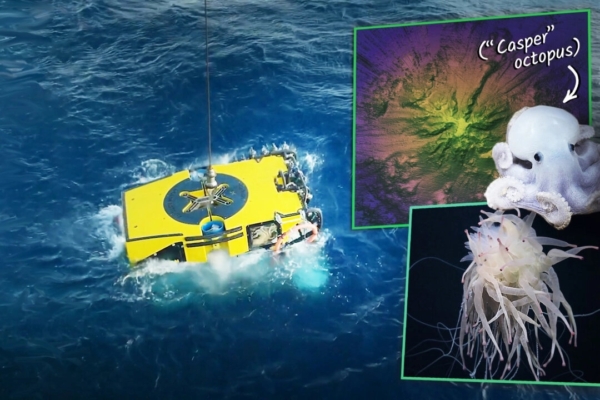A remote-controlled deep-sea robot has detected a sponge garden and ancient corals thousands of feet deep in the Pacific Ocean for the first time. This hidden ecosystem was discovered thriving on a newly found underwater mountain – also known as a seamount – off the west coast of South America.
During an oceanographic expedition led by the Schmidt Ocean Institute founded by Eric and Wendy Schmidt, a research team announced the discovery of this seamount along the Nazca Ridge, located 900 miles off the coast of Chile. The seamount, one of several recently found by the team, spans approximately 43 square miles with its base reaching a depth of about 2.5 miles (4000 meters) and its summit rising 1.9 miles (3040 meters) above the ocean floor. The highest point is situated 0.6 miles (960 meters) beneath the surface.
Onboard the Falkor research vessel, scientists operated a remotely operated vehicle (ROV) named Subastian to explore and map the seamount in high resolution using a multibeam echo sounder sensor. The ROV discovered sponge gardens and ancient corals nourishing a diverse deep-sea ecosystem thriving on the seamount.
The exploration included a 28-day survey of the rugged Nazca Ridge, which runs parallel to the Salas y Gómez Ridge in the southeastern Pacific. This investigation is one of several scientific expeditions conducted in the region, during which the team has announced many discoveries for the first time.
In addition to the new seamount biological community, the research team made other groundbreaking discoveries. During a previous dive, scientists found another seamount hosting a pristine coral garden covering an area of about half a square mile, roughly the size of three tennis courts.
They also observed marine creatures never before captured on video in the ocean, including a species of squid known as Promachoteuthis, discovered recently ensnared in a net. In the depths of the South Pacific, they encountered a peculiar creature previously unseen in the region: a cute-looking octopus known as the Casper octopus.
Among the other notable marine life discovered were two rare Bathyphysa siphonophores, affectionately referred to as “flying spaghetti monsters,” which were documented during the expedition.
The discoveries did not stop there. During hundreds of dives conducted throughout the expedition, the team recorded a large bamboo coral habitat housing basket stars, crinoids, sea stars, and serpent stars.
A major highlight of their research was identifying new species. The third and most recent expedition collected 20 previously unknown species, adding to the 150 species recorded during two expeditions in January and February.
“After concluding the third exploration of the region, we have now explored about 25 seamounts on the Nazca and Salas y Gómez Ridges,” said marine technician Tomer Ketter in a press release from the Schmidt Ocean Institute. “Our findings showcase the remarkable diversity of these ecosystems and reveal gaps in our understanding of the interconnectedness of seamount ecosystems.”
On the research vessel, Ketter oversaw mission control and monitored the ROV alongside Michael Rae and Erin Easton. Another scientist onboard, Alex Rogers, noted that these underwater mountains provide an incredible biodiversity.
“The seamounts in the southeastern Pacific exhibit significant biodiversity with species not found anywhere else to date,” Rogers stated. “Our taxonomists’ work onboard Falkor, supported by the Schmidt Ocean Institute team, will greatly enhance our understanding of the distribution of extraordinary life forms on these seamounts, including some life forms previously unrecorded or unseen by human eyes.”
The lush 2.5-mile-high seamount has sparked the imagination of some scientists. Jyotika Virmani, Executive Director of the Schmidt Ocean Institute, expressed excitement about discovering “a new seamount that is approximately 2 miles high – almost four times the height of the Burj Khalifa – with a vibrant ecosystem.” She added, in curiosity, “Only 26% of the seafloor has been mapped at this high resolution, and each Falkor expedition sheds light on more of the unknown seafloor and life on our home planet.”
Overall, the recent discoveries conducted by the Schmidt Ocean Institute’s research team on the seamounts in the Pacific Ocean have shed light on the thriving deep-sea ecosystems and the incredible biodiversity present below the ocean’s surface. It emphasizes the importance of continued exploration and understanding of these unique and previously unknown marine habitats.

